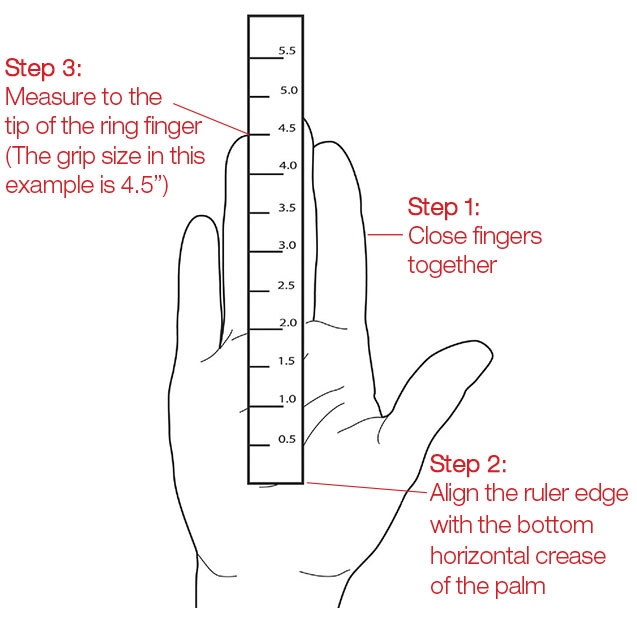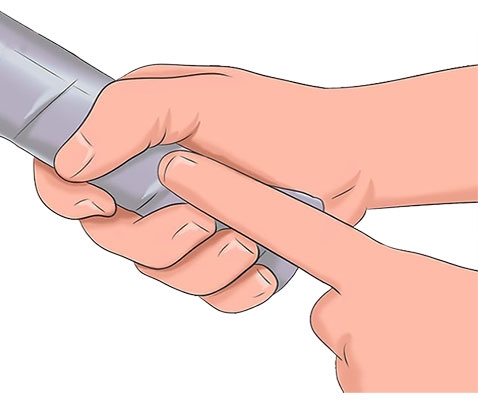
How Tennis Racket Grip Sizes Are Measured
Tennis racket grip sizes are determined by measuring the circumference around the edge of the handle. This circumference is measured in the middle of the racquet handle and the sizes range from 4 inches to 4 3/4 inches.
The chart below lists the different tennis racquet grip sizes that are offered in the United States and the corresponding European grip sizes.
| US Sizes | European Sizes | Sizes in Millimeters |
|---|---|---|
| 4 inches | 0 | 100-103 mm |
| 4-1/8 inches | 1 | 103-106 mm |
| 4-1/4 inches | 2 | 106-110 mm |
| 4-3/8 inches | 3 | 110-113 mm |
| 4-1/2 inches | 4 | 113-118 mm |
| 4-5/8 inches | 5 | 118-120 mm |
| 4-3/4 inches | 6 | 120-123 mm |
How To Measure Your Grip Size
The two common methods used to identify your tennis racket grip size are the ruler test and the index finger test. It is recommended to use a combination of these two methods to find the ideal grip size for you.
Ruler Test: To measure grip size using the ruler test, first place the fingers of your racket hand together, then align a ruler's edge with the bottom horizontal crease of your palm. Next, measure to the tip of your ring finger, this measurement is your grip size. In the diagram below, the measured grip size is 4.5". In general, the measured length should fall between 4 inches and 4 5/8 inches. This measurement gives you a starting point in determining the perfect grip size for you. To be certain of your ideal grip size, actually hold a racket with a grip size closest to what you measured, and employ the index finger test (see a description of index finger test below).

Index Finger Test: Hold the racket in your hitting hand using an eastern forehand grip (where the palm is placed on the same grip bevel as the string face). Place the index finger of your non-hitting hand in the space between your ring finger and palm (see diagram below). If there is not enough room to fit your finger in this space, the grip is too small. A grip that is too small would require more hand strength to prevent the racket from twisting in your hand, which could result in tennis elbow problems. Conversely, if there is a large gap between your index finger and the ring finger and palm of your hitting hand, the grip is too big. A grip that is too big will prevent you from properly snapping your wrist on serves, and can also lead to tennis elbow problems. Ultimately, you want the index finger to fit snugly between the ring finger and palm of your hitting hand, with little or no space between. This will give you the most comfortable and secure grip.

Other Helpful Racket Tips:
In general, the younger the tennis player, the smaller the racket grip should be. It is recommended that children ages 4 - 10 are more suited to the smallest grip size, either 4” or 4 1/8”. Lightweight rackets with smaller grips help to develop proper technique and control.
For junior-level players, between 11 and 14 years of age, junior-level grip sizes ranging from 4 ¼” and 4 3/8” should be comfortable enough and allow for proper handling of the racket.
Adults would be more comfortable with adult tennis rackets with larger grips, between 4 1/8” and 4 ¾”.
While you can make a general assumption based on age, ultimately, the player’s hand size is the most important factor to consider, along with personal preference, comfort, and playing style. If you find your tennis grip isn’t as secure or comfortable as you’d like it to be, it may be time for a new racket. Alternatively, you can also make thickness adjustments to your grip size with tennis grip overlays.
Racket grip sizes go a long way toward skill development, performance, and enjoyment. With the right grip size, your swings will start to come more naturally, and you’ll be able to focus more on playing your best game, and less on your equipment.










